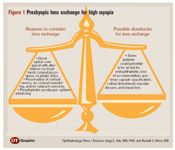Article
Debate continues over presbyopic lens exchange
Chicago-The future of presbyopic lens exchange for high myopia looks bright with the development of various IOL options, according to one proponent. Yet, surgeons and patients should be aware of possible complications, such as retinal detachment, and seek alternatives, cautions another refractive surgeon.

Randall J. Olson, MD, the John A. Moran Presidential Professor and chairman, department of ophthalmology and visual sciences, University of Utah, Salt Lake City, said that refractive lens exchange (RLE) for this patient population is "a great solution for a dual problem," when he emphasized its advantages in a forum of controversial procedures in refractive surgery during the American Academy of Ophthalmology annual meeting.
Jorge L. Alio, MD, PhD, professor and chairman, University Miguel Hernandez, Alicante, Spain, and medical director, Vissum Corp., Spain, disagreed with Dr. Olson's assessment, presenting the risk for retinal detachment and other complications as too high in these cases during his presentation at the annual meeting.
As someone with firsthand experience having a refractive error of –8 D, Dr. Olson does not favor glasses, which can be easily lost. In fact, reading is nearly impossible with no correction, he explained, since one can't use both eyes together for near vision.
Corneal corrections have their limits for high myopia and there is also the risk of corneal ectasia.
However, "there is good evidence that corneal treatment may be done with new laser treatments. But there is still an increased retinal detachment risk in this group," Dr. Olson said.
Phakic IOLs are another avenue that surgeons may consider, although they have their own set of risks, such as dislocation, endothelial cell loss, surgically induced cataract, etc.

Presbyopic lens exchange is in its infancy but will likely take off when new lens options become available, Dr. Olson said. The dual-optic accommodating IOL (Synchrony, Visiogen) is one of the pseudophakic presbyopic options in development. The lens can be implanted through a 3.5-mm incision and offers very good near vision, he added.
The NuLens Accommodating IOL (NuLens Ltd.) provides accommodation by changing its true power within the eye. The lens is designed with a small chamber of silicone gel and a posterior piston with an aperture in its center that allows the gel to bulge relative to the forces generated by accommodation.
"This powerful technology allows a range of 10 D of accommodation and is about ready to enter clinical trials," Dr. Olson noted.
The Light Adjustable Lens (Calhoun Vision) is another unique option in development, which will allow for customized correction using light-sensitive material. The curvature of the lens can be altered using a laser, he said.

He added that surgeons can offer good results of pseudo-phakic refractive pre-cision with 90% of cases reaching ±0.5 D with the IOLMaster. In addition, there are low-power piggyback lenses that are available to help achieve ±0.25 D of attempted correction.
Newsletter
Don’t miss out—get Ophthalmology Times updates on the latest clinical advancements and expert interviews, straight to your inbox.





